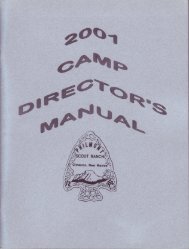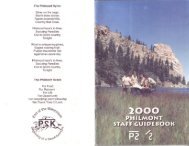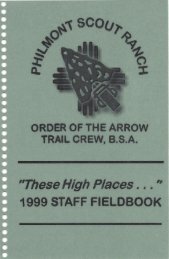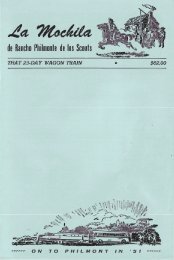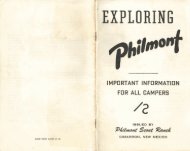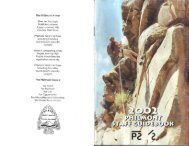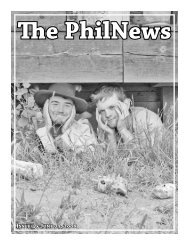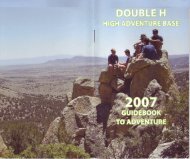Guidebook 2008.pdf
Guidebook 2008.pdf
Guidebook 2008.pdf
You also want an ePaper? Increase the reach of your titles
YUMPU automatically turns print PDFs into web optimized ePapers that Google loves.
DAYTWO AT PHILMONT<br />
At Headquarters<br />
After breakfast, check out of tent city and report to the Welcome Center at<br />
the time scheduled for your departure.<br />
Enroute to Starting Camp<br />
A Philmont bus will take your crew within hiking distance of your starting<br />
camp. Be prepared to hike to your camp.<br />
Starting Camp<br />
Here your Ranger will work with you on:<br />
• Mountain hiking and camping skills<br />
• Map and compass navigation<br />
• Adjusting to high elevations<br />
• Trail and personal safety and first aid<br />
• Lightning Safety<br />
• Stove and liquid fuel safety<br />
• Fire building and extinguishing (conditions permitting)<br />
• Cooking dehydrated menus at high elevations<br />
• Water purification process<br />
• Camp and personal sanitation<br />
• Wilderness Pledge-your personal commitment<br />
• Conservation and environmental awareness<br />
• Low-impact and minimum-trace camping skills and techniques<br />
• Bear, Mountain Lion and wildlife procedures<br />
DAYTHREE AT PHILMONT<br />
After a good night's sleep and a good breakfast in starting camp your Ranger<br />
will hike with you on the first leg of your Philmont trek. Your Ranger will<br />
be on hand to assist you and will offer constructive ideas on how to sharpen<br />
your camping skills. When your crew has achieved reasonable proficiency in<br />
hiking and camping skills, your Ranger will leave you (usually early in the<br />
morning of your fourth day). Then you are strictly on your own.<br />
Hiking on Philmont<br />
Philmont abounds with picturesque hiking areas. Every section of the ranch<br />
has many opportunities for stimulating and beautiful hikes. Take time to<br />
enjoy those scenic panoramas, delicate wild flowers, rippling streams, majestic<br />
peaks and towering trees. Some of the most beautiful scenery is along<br />
little-used trails and remote trail camps. When your crew is quiet you may<br />
see wildlife including deer, turkey, porcupine, elk, bobcat, coyote, badger,<br />
and bear. Be sure to record the animals you see on your wildlife census card.<br />
Hiking on Philmont is often difficult. Weighty packs, steep trails, and high<br />
altitudes challenge even the best backpackers. Remember, your trek is a<br />
team effort. Stronger hikers are expected to help weaker ones. Faster hikers<br />
should hike near the end of the line and encourage the slower ones in front.<br />
Your crew should always hike together, within hearing of one another.<br />
This avoids the terrifying experience of someone being lost. Due to risks<br />
involved, Philmont strongly discourages hiking at night.<br />
la<br />
Horse Brand<br />
pa<br />
Cattle Brand<br />
24<br />
25





